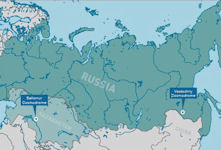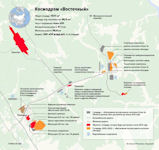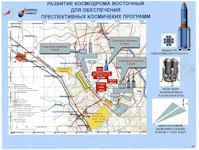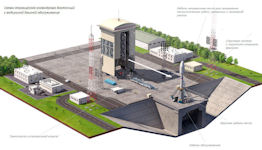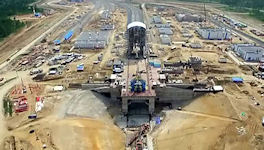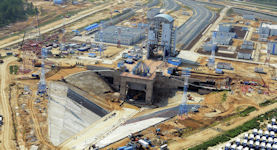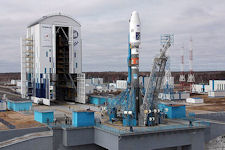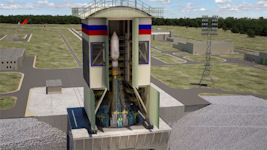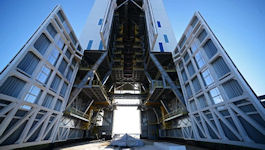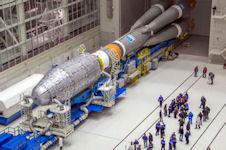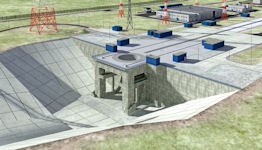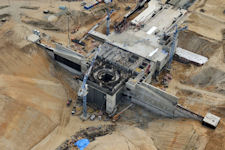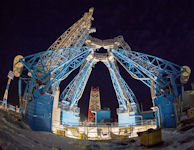Vostochniy Cosmodrome
Fifth Space Launch Center
The formal commissioning of the first stage of the Vostochny cosmodrome is being postponed due to the identified non-critical shortcomings. This was announced by the Director General of Roscosmos Dmitry Rogozin at a meeting with State Duma deputies from the Liberal Democratic Party. “Now, with the help of Roskosmos, or rather our organization, the Center for the Operation of Ground-Based Space Infrastructure, we are eliminating the remaining shortcomings. There are no critical, dangerous ones, <...> all these comments are related to the lack of documentation. papers. <…> Because of this, we formally cannot put the first stage into operation. It has been built, it is working. There are no concerns in terms of functioning," he said.
Vostochny is the first Russian civil cosmodrome. It is located in the Amur Region near Tsiolkovsky (the city arose in 2015 on the site of the former village of Uglegorsk). The decree on the creation of the cosmodrome was signed by the President of the Russian Federation in 2007. As part of the first stage of construction in 2012-2016, a universal launch complex for launch vehicles of the Soyuz-2 series was erected here. The second stage of the construction of the cosmodrome involves the construction of a launch pad for the Angara-A5 launch vehicles and related infrastructure. It is assumed that the construction of the second stage will be completed at the end of 2022, and the first launch will take place at the end of 2023.
Russia sent three satellites into orbit 28 April 2016 after conducting the first ever rocket launch from the new spaceport in its Amur region. The Soyuz rocket took off from the new Vostochny Cosmodrome, with President Vladimir Putin attending the launch near the Chinese border. The opening of the spaceport in eastern Russia would reduce Moscow's dependence on the Baikonur cosmodrome in Kazakhstan.
The intent of the Vostochniy Cosmodrome is to replace many if not all the capabilities of the Baikonur Cosmodrome located in Kazakhstan. It will feature 1,500 facilities including two launch pads initially. Additional hotels, tourist, training, medical and liquid hydrogen and liquid oxygen production facilities as well as a Shuttle airport for aircraft and spacecraft utilization are planned. It will be supported by a city with homes for 35,000 people. The facility is supposed to be able to service inclinations of 98, 83, 73.2, 72, 63 and 51.7 or 51.8 degrees respectfully. It is slated to account for as much as 45% of the Russian Federation space launches with 44% remaining with Plesetsk and 11% with the Baikonur Cosmodrome.The facility infrastructure cost to completion is expected to cost around 80.5 billion Rubles ($2.7 billion).
Russia's President Vladimir Putin arrived at Vostochny for its first launch, which was scheduled to take place at 5:01am Moscow time (02:01GMT) on 27 April 2016. However, automatic systems canceled the launch of a Soyuz-2.1a space rocket less than two minutes before the liftoff. Putin said those responsible for crimes during the construction of the Vostochny Cosmodrome won’t escape responsibility if their guilt is proven, and will swap house arrest for prison bunks. "Six criminal cases had to be launched, in which four people were arrested. Two of them, however, are under house arrest, while the other two are in pre-trial detention,” Putin said. “But if their guilt of the suspected of crimes is proven, they’ll have to swap their warm beds at home for prison bunks," he added.
The first launch at Vostochny was initially expected in 2015, but was postponed to April 2016 due to mismanagement of the project and poor performance by subcontractors. At some point during construction, the workers at the site had to go on strike after salaries were delayed. Criminal investigations into alleged embezzlement and other corruption-related crimes were launched against those involved in the construction of the cosmodrome.
The fifth space center, the new Vostochniy (Eastern) Cosmodrome was initally projected to be opened for crewed flight operations in 2018-2020 and un-crewed flight operations in 2015 This is intended to become Russia ’s new piloted mission launch center. Construction on the Vostochniy Cosmodrome in the Amur Region of the Russian Federation was not to officially start until summer 2011 with completion expected in 2015 or afterwards funds provided. Design work and construction surveying layout stakes in the ground had been in progress for the several years with at least some defoliation efforts in progress.
On October 22, 2005, Russian Federation government approved FSP 2006-2015 expanded spaceflight development decision was based on the re appearance of the Soviet era like Five Year Plan ( 2006-2010) and the next five year plan called the five year Forecast Plan (2011-2015) cycle to Russian Federal Space Agency developments. Soon the Russian Federal Space Agency will replace the present FYP with the 2011-2015 five year plan followed by the 2016-2020 forecast plan. These decisions will be critical to the real things that will get funded to happen in the next five year planning cycle.
After this Russian administration decision was made in October 2005 it was found out that it was going to be much more difficult and expensive than expected but it continues. Whether the Federal Space Agency (“Roskosmos”) sticks with its plans or is considering returning to Baikonur remains to be seen in its upcoming new five year plan and of the ten year total plan through 2016-2020.
The decision to build the new launch site was made in 2007 when it became clear that the old Soviet-era infrastructure in Kazakhstan required substantial investment. Russia decided it was pointless to invest heavily on another country's soil, not to mention that it also paid for the use of Baikonur; annual rent and operation costs amount to approximately $225 million USD. Vostochny's price tag, however, is steep, and Russia is spending an estimated $6-10 billion dollars on the entire complex and relevant infrastructure.
The decisions by the Russian Federation government of July 19, 2010 now appear to have been made by committing to the first phase of the construction 24.7 billion Rubles [$809 million dollars] to the new Vostochniy (Eastern) Cosmodrome full construction over the next three years 2011-2013 with other funding to follow to make itself independent of Baikonur Cosmodrome in Kazakhstan.
This primarily civilian mission space launch center is to be open to international partners and its Russian space industry developers. This national effort will require massive capital investment in national resources and equipment demands as well as 5,000 -12,000 construction specialist and upwards of 30,000 personnel with various skills requiring housing, roads, highways and railroads including a modern airport. The development of the major Amur Federal Highway called Chita-Khobarovsk which passes the launch infrastructure will provide needed access from major cities of the region once fully developed.
The small Vostochniy Cosmodrome will occupy only 700 square kilometers verses the large sprawling Baikonur Cosmodrome. All of the launch sites to be developed there are not all expected to be completed until just before 2050 when Baikonur will essentially become an abandoned historic site. Those launch facilities infrastructure will first accommodate the RUS-M medium to heavy lift booster two launch sites then two Soyuz, two Rokot silo sites, and perhaps two Angara sites as well as two Zenit-2, 3 booster’s facilities.
“The Russian military simply was not prepared to be diplomats with the Kazakhstan’s” which has not helped the Baikonur Cosmodrome future prospects. Whether this new launch infrastructure come to fruition depends in large part on the economic reality of the Russian economy to support its fulfillment in the face of the world economic crisis.
By 2014 Russia was planning to start construction of a launch pad for a new heavy-class carrier rocket at a future space center in the Far East next year to set the stage for its maiden manned launch in 2018. Russia is building a launch complex for the Angara rocket family at the country’s new Vostochny space center to reduce dependence on Kazakhstan for space launches. Moscow leases the Baikonur space center for $115 million per year. Angara launch facilities at Vostochny will be built in two stages: the first launch pad will ensure the launch of a light-class Angara rocket in 2015, while the second will host heavy-class Angara rockets, which would carry out unmanned resupply as well as piloted missions.
President Vladimir Putin on 02 September 2014 ordered that construction be sped up on the multi-billion-dollar spaceport, which he said would break reliance on the Baikonur cosmodrome in Kazakhstan and launch future missions to the Moon and Mars. Putin said construction was lagging behind by up to three months, and the 6,000 workers currently at the site are half as many as needed.
Tsiolkovsky is a closed Town in Amur Oblast, Russia, that serves the nearby spaceport, Vostochny Cosmodrome. The Vostochny Cosmodrome is located near two small cities that are closed to outsiders; only those with a local residency permit, or special entry permission, can visit. Uglegorsk has existed since time immemorial, while the city of Tsiolkovsky is still under construction. Technically, both cities merged in 2014 and now there is only Tsiolkovsky, but the road that will connect them is yet to be completed. Still not used to the new name, locals continue to refer to the older Soviet-era city as Uglegorsk.
According to Dmitry Tetenkin, deputy chairman of the Amur region's government, the regional authorities requested the inclusion of Uglegorsk in the Russian Space Agency's federal program to develop space centers from 2016 to 2025. Plans call for gas mains to be installed, 33 apartment buildings to be renovated, 20 kilometers of roads to be repaired, and athletic facilities to be built. In addition, the city will receive a cultural complex with a modern library and a children's center. Schools and kindergartens will be needed.
Top specialists will receive apartments in Tsiolkovsky, which will house 20,000 residents. So far, it looks merely like a new neighborhood and not a city. Still, specialists are pouring in from Baikonur, and also from major Russian cities.
Although officials for several years had talked about the advantages of constructing a new Russian cosmodrome in the Far East, not until early 1994 were specific plans set in motion. The selected site is a former ICBM base named Svobodny. Its latitude is essentially equivalent to the minimum orbital inclination now permitted from Baikonur. The first space launches from Svobodny in 1997, was with be with START boosters. Proposals to operate the future Angara launch vehicle from Svobodnyy met initial resistance from the Russian government.
The first space center near Uglegorsk was built in 1996. Named Svobodny for the district in which it is located, this space center began to take away some launches from Baikonur. The site was not chosen randomly. Since 1969, the Svobodny district was home to a strategic military missile division. In order not to attract attention to the construction of launch facilities for ballistic missiles, the closest town was named Uglegorsk; ("ugol" is the Russian for coal). Coal, however, was never produced there, and the town received the status of a closed city.
In 1994, the missile division was disbanded, but the military began to work at the Svobodny Cosmodrome, which was put into operation two years later. Over the next 10 years it launched five rockets - one Russian and four foreign (American, Swedish, and two Israeli). In 2007, Svobodny ceased to operate and construction began on the Vostochny Cosmodrome, which would be twice as large as the old site.
The Vostochniy cosmodrome’s construction began in January 2011 and as of late 2014 was expected to be completed by 2018. The first launch was scheduled to take place in July 2015, and the first launch of a piloted spacecraft is expected in 2018. The construction workers repeatedly said that they are failing to meet the tight deadlines, so in 2014 Dmitry Medvedev supported the idea of establishing a coordination center at the construction site, saying that it was difficult to direct the works all the way from Moscow.
Russia’s Federal Space Agency, Roscosmos, announced 25 October 2013 a tender for construction of launch facilities for Soyuz-2 carrier rockets at the future Vostochny spaceport, being built in Russia’s Far East. The tender, worth 695 million rubles (some $22 million), stipulates the completion of construction by November 25, 2015. The newly appointed head of Roscosmos, Oleg Ostapenko, said Friday that the Vostochny project included construction of two launch pads: one for Soyuz-2 and another for Angara-family carrier rockets. The initial launches at Vostochny were slated for 2015, while the entire space center is scheduled for completion by 2020.
The Vostochny space center is intended to reduce Russia’s reliance on Baikonur, located in the steppes of southern Kazakhstan and currently leased by Moscow. Vostochny is expected to host 45 percent of Russia’s space launches and all its manned flights from 2020, while Baikonur’s share will fall from 65 percent to 11 percent, with the remainder going to Plesetsk in Russia’s Far North, according to Roscosmos. The spaceport will occupy more than 1,000 square kilometers (386 square miles) in the Far Eastern Amur region.
Soyuz-2 is a three-stage carrier rocket for placing payloads into low-Earth orbit. The Soyuz-2 family includes 2.1a, 2.1b and 2.1v variants. The first two variants are modifications to the Soyuz-U launcher. The Soyuz-2.1v is a “light” version, without side boosters. Soyuz-2 launches were carried out from Plesetsk and Baikonur.
Dozens of people have already been put in prison over the massive embezzlement during the construction of the Vostochny Cosmodrome, but somehow it hasn’t been enough to set things straight there, Vladimir Putin pondered 11 November 2019 . The Russian president grilled the government for allowing misappropriation of state funds at the Vostochny Cosmodrome and other large-scale state construction projects on Monday. He reminded the ministers that it wasn’t the first time he has addressed the problem.
"We’ve said it a hundred times – work transparently as big money is being allocated; it’s practically a national project. But no, they keep stealing in hundreds of millions!" Massive fraud during the construction of Vostochny saw “dozens of criminal cases being launched,” the president said. “The courts have already decided on some of them; people have been put in prison. But things haven’t been set straight there by now.” Putin tasked the prosecutor’s office and investigative bodies with “keeping a close eye” on the project, expressing hope that proper working order will be finally arranged at the ill-fated cosmodrome.
Russia began building Vostochny in the Far Eastern Amur Region on the Chinese border in 2012 to reduce the dependence of its space program from the Baikonur Cosmodrome, which is located in Kazakhstan and is rented by Russia's space agency, Roscosmos, from the country. A state-of-the-art space port is also paramount as Russia plans to retire its Proton heavy launch vehicles and replace them with modern and eco-friendly missiles. One of those is Angara-A5, which is seen as the backbone of the Russian moon program, which aims to establish a permanent base on the Earth’s satellite and bring people there in the coming decades.
Sources and Methods:
- Former Svobodnyy-18 ICBM Base To Launch Satellites , Russian Television and Dubl Networks, 7/27/1994
- Will We Build Svobodnyy?, Major General Valeriy Menshikov and Colonel Anatoliy Kuzin, ARMEYSKIY SBORNIK, April 1995 -- Supports establishing a second space launch facility in Russia.
- More on New Cosmodrome's Opening , NTV, 3/9/1997 -- Video report from Svobodnyy Cosmodrome
- Protest Held Against Launch of Start-1 Rocket , Oleg Yemelyanov , ITAR-TASS, 3/3/1997 -- A demonstration of protest against environmental effects of the planned launching of Start-1 booster-rocket from Svobodniy cosmodrome, the Amur region, was held in Yakutsk today.
|
NEWSLETTER
|
| Join the GlobalSecurity.org mailing list |
|
|
|


